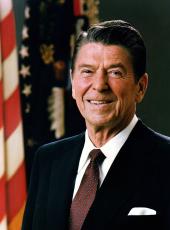The President. Thank you all very much. Audience member. 8 more years!
The President. This is a great view from up here. It's kind of like being at a Saturday night, tag team wrestling match at the Garden. [Laughter]
But in a few minutes I'll ring the bell so trading can begin.
Audience. Boo-o-o!
The President. Well, I know that if I don't, it'll ring itself, anyway, so— [laughter] —but in this lull before the storm, I'd like to say a few words about where this country's been and where we'll be going from here. The last time I visited the New York Stock Exchange was in 1980, and the mood sure was different then.
But in the last 5 years, we've moved from malaise to hope, confidence, and opportunity. We knew that malaise for what it really was: Government, with its high taxes, excessive spending and overregulation, had thrown a wrench in the works of our free markets. In essence government was trying to run the economy, but was ruining it instead.
So, we cut tax rates and counterproductive regulations and moved to limit spending growth. On those regulations, our estimate is that we have eliminated enough regulations to save 300 million man-hours a year that the public and local and State governments used in filling out government forms to meet the regulations.
And I think we've seen some healthy results on this trading floor. Those tax cuts helped reenergize the stock market, with the volume of shares traded hitting record highs and more Americans than ever before participating in the market. An enormous rush of new equity issues, venture capital, and new investment became the driving force behind an economic expansion as strong as any we'd seen in more than 20 years.
And for all those who say we can't repeat the dramatic growth or record of the past 2 years, I can only paraphrase my Chief of Staff: We're bullish on the American economy.
The American economy is like a race horse that's begun to gallop out in front of the field. Other nations, hobbled by high tax rates and weighed down by oversized government spending, have been slow to catch up. And this has caused some painful dislocations, especially for America's exporting industries. But the answer is hardly to hamstring the American economy to make it drop back with the others. The solution is for our trading partners to throw off the dead weight of government—cut their own tax rates, spending, and overregulation and join us in opening up their markets to foreign competition so they can catch up with us in our race to the future.
There's one sure method to cut the expense and price of American-made goods and increase our export sales. The surest way to make American products more competitive is to spur innovation, enterprise, and productivity by cutting tax rates again. And that's exactly what we intend to do.
It's time, too, that government got off its present spending spree before it squanders our future prosperity. Senate Republicans are trying to put together a package of genuine spending reductions, and they're going to need all of our support and encouragement in the coming weeks. And let me repeat again, if the political heat of budget cutting is too much for Congress, then they should give the President what 43 Governors have—a line-item veto. And if Congress can't cut, I will. And let me tell you it really would make my day.
With tax reform and budget control, our economy will be free to expand to its full potential, driving the bears back into permanent hibernation. That's our economic program for the next 4 years. We're going to turn the bull loose.
Audience. Ronnie! Ronnie! Ronnie!
[At this point, the President rang the bell opening the trading session.]
The President. Okay. Thank you all very much. Thank you. What you have done for me is better than a hot tip.
Note: The President spoke at 9:53 a.m. from the New York Stock Exchange trading floor rostrum. Following his remarks, the President met with members of the stock exchange and financial executives in the boardroom.
Ronald Reagan, Remarks to Brokers and Staff of the New York Stock Exchange in New York, New York Online by Gerhard Peters and John T. Woolley, The American Presidency Project https://www.presidency.ucsb.edu/node/259510


